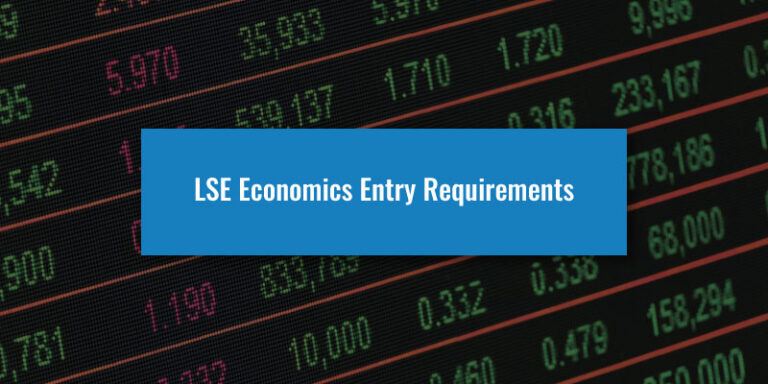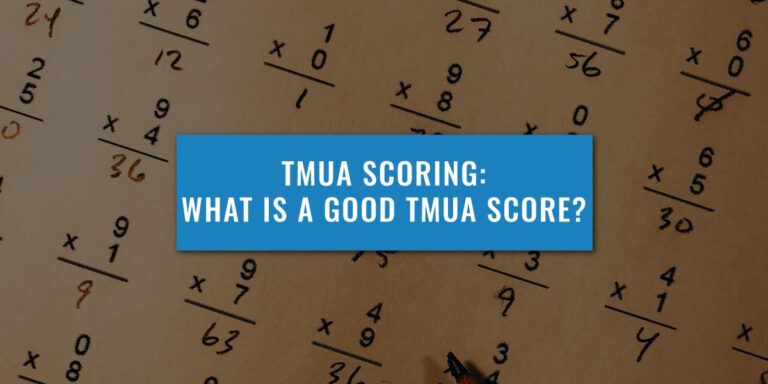The ECAA is no longer being used for Cambridge Economics. The TMUA is used instead for 2022 Economics Applicants.
The second part of Section 1 of the ECAA tests principles of Advanced Mathematics.
Section 1 (A and B) is a 60-minute section with 40 questions so students have just over 2 minutes for each question. Students often lose the most marks by wasting their minimal time on tricky questions. You have to answer 20 questions in each section.
The questions can be quite difficult and it’s easy to get bogged down. However, it’s well worth spending time preparing for this section as it’s possible to rapidly improve with targeted preparation. Here is our guide to ECAA Section 1B.
Again, let’s begin with a (difficult) practice question:
This is the difficulty you should expect in the actual exam. You will find the answer at the end of this guide.
What You Need To Know
We strongly advise you to go through the ECAA Specification and ensure that you have covered all examinable topics.
Make sure you take some time to revise these topics before carrying on – there is little to be gained by attempting these questions with huge gaps in your knowledge. A summary of the major topics is given below:
| AM1.1 | Laws of indices for all rational exponents |
| AM1.2 | Use and manipulation of surds. Simplifying expressions that contain surds, including rationalising the denominator. |
| AM1.3 | Quadratic functions and their graphs; the discriminant of a quadratic function; completing the square; solution of quadratic equations. |
| AM1.4 | Simultaneous equations: analytical solution by substitution, e.g. of one linear and one quadratic equation. |
| AM1.5 | Solution of linear and quadratic inequalities. |
| AM1.6 | Algebraic manipulation of polynomials, including: a. expanding brackets and collecting like terms b. factorisation and simple algebraic division (by a linear polynomial, including those of the form ax + b, and by quadratics, including those of the form ax2 + bx + c) c. use of the Factor Theorem and the Remainder Theorem |
| AM1.7 | Qualitative understanding that a function is a many-to-one (or sometimes just a one-to-one) mapping. Familiarity with the properties of common functions, including f(x) = x (which always means the ‘positive square root’) and f(x) = x . |
| AM2.1 | Sequences, including those given by a formula for the nth term and those generated by a simple recurrence relation of the form xn+1 = f(xn) |
| AM2.2 | Arithmetic series, including the formula for the sum of the first n natural numbers. |
| AM2.3 | The sum of a finite geometric series. The sum to infinity of a convergent geometric series, including the use of r <1 |
| AM2.4 | Binomial expansion of (1 + x)n for positive integer n, and for expressions of the form ( a + f(x))n for positive integer n and simple f(x). The notations n! and (n / r). |
| AM3.1 | Equation of a straight line, including: a. y – y1 = m(x – x1) b. ax + by + c = 0 Conditions for two straight lines to be parallel or perpendicular to each other. Finding equations of straight lines given information in various forms. |
| AM3.2 | Coordinate geometry of the circle, using the equation of a circle in the forms: a. (x – a)2 + (y – b)2 = r2 b. x2 + y2 + cx + dy + e = 0 |
| AM3.3 | Use of the following circle properties: a. The perpendicular from the centre to a chord bisects the chord. b. The tangent at any point on a circle is perpendicular to the radius at that point. c. The angle subtended by an arc at the centre of a circle is twice the angle subtended by the arc at any point on the circumference. d. The angle in a semicircle is a right angle. e. Angles in the same segment are equal. f. The opposite angles in a cyclic quadrilateral add to 180°. g. The angle between the tangent and chord at the point of contact is equal to the angle in the alternate segment. |
| AM4.1 | The sine and cosine rules, and the area of a triangle in the form 1/2 absinC. The sine rule includes an understanding of the ‘ambiguous’ case (angle–side–side). Problems might be set in 2 or 3 dimensions. |
| AM4.2 | Radian measure, including use for arc length and area of sector and segment. |
| AM4.3 | The values of sine, cosine and tangent for the angles: 0°, 30°, 45°, 60°, 90°. |
| AM4.4 | The sine, cosine and tangent functions; their graphs, symmetries, and periodicity. |
| AM4.5 | Knowledge and use of the equations: a. tan θ = sin θ / cos θ b. sin2 θ + cos2 θ = 1 |
| AM4.6 | Solution of simple trigonometric equations in a given interval (this may involve the use of the identities in 4.5). |
| AM5.1 | y = ax and its graph, for simple positive values of a. |
| AM5.2 | Laws of logarithms and special cases. |
| AM5.3 | The solution of equations of the form ax = b, and equations which can be reduced to this form, including those that need prior algebraic manipulation. |
| AM6.1 | The derivative of f(x) as the gradient of the tangent to the graph y = f(x) at a point. a. Interpretation of a derivative as a rate of change. b. Second-order derivatives. c. Knowledge of notation. Differentiation from first principles is excluded. |
| AM6.2 | Differentiation of xn for rational n, and related sums and differences. This might require some simplification before differentiating. |
| AM6.3 | Applications of differentiation to gradients, tangents, normals, stationary points (maxima and minima only), increasing functions [ f ′(x) ≥ 0] and decreasing functions [ f ′(x) ≤ 0 ]. Points of inflexion will not be examined, although a qualitative understanding of points of inflexion in the curves of simple polynomial functions is expected. |
| AM7.1 | Definite integration as related to the ‘area between a curve and an axis’. The difference between finding a definite integral and finding the area between a curve and an axis is expected to be understood. |
| AM7.2 | Finding definite and indefinite integrals of xn for n rational, n ≠ 1, and related sums and differences, including expressions which require simplification prior to integrating. |
| AM7.3 | An understanding of the Fundamental Theorem of Calculus and its significance to integration. |
| AM7.4 | Combining integrals with either equal or contiguous ranges. |
| AM7.5 | Approximation of the area under a curve using the trapezium rule; determination of whether this constitutes an overestimate or an underestimate. |
| AM7.6 | Solving differential equations of the form dy / dx = f (x) |
| AM8.1 | Recognise and be able to sketch the graphs of common functions that appear in this specification: these include lines, quadratics, cubics, trigonometric functions, logarithmic functions, exponential functions, square roots, and the modulus function. |
| AM8.2 | Knowledge of the effect of simple transformations on the graph of y = f(x) with positive or negative value of a as represented by: a. y = af(x) b. y = f(x) + a c. y = f(x+a) d. y = f(ax) |
| AM8.3 | Understand how altering the values of m and c affects the graph of y = mx + c |
| AM8.4 | Understand how altering the values of a, b and c in y = a(x+b)2 + c affects the corresponding graph. |
| AM8.5 | Use differentiation to help determine the shape of the graph of a given function, including: a. finding stationary points (excluding inflexions) b. when the graph is increasing or decreasing |
| AM8.6 | Use algebraic techniques to determine where the graph of a function intersects the coordinate axes; appreciate the possible numbers of real roots that a general polynomial can possess |
| AM8.7 | Geometric interpretation of algebraic solutions of equations; relationship between the intersections of two graphs and the solutions of the corresponding simultaneous equations. |
Extras to know
In this specification, it should be assumed that, where mention is made of a particular quantity, knowledge of the SI unit of that quantity is also expected (including the relationship of the unit to other SI units through the equations linking their quantities).
Candidates are expected to be familiar with the SI prefixes (for the range 10-9 (nano) to 109 (giga)). There is also an assumed background knowledge of Numbers, Algebra, Geometry, Statistics and Probability.
- Don’t be afraid to skip and come back to questions
You should do a lot of practice beforehand to ensure you know the timing of the test very well before employing this tip. You can skip questions that will “waste” your time. If a question is difficult and it’s taking you longer than it should do, skip it, make a mental note and come back to it at the end.
How is Section 1 of the ECAA scored?
In Section 1, each correct answer scores 1 mark and is scored on a scale of 1.0 to 9.0. No marks are deducted for incorrect answers. Results for Part A and Part B are reported separately.
Most students score between 3.0-5.0 on Section 1A and the strongest candidates score over 6.0. This is the same with Section 1B but you should aim for 6.5 to stand out from other applicants.
ECAA Section 1B worked example
ECAA Section 1B Question:
ECAA Section 1B Answer:
Looking for support to help you get your dream Economics offer from Cambridge?
At UniAdmissions, we are experts at maximising your chances of gaining a place to study Economics at Cambridge. We provide TMUA specialised support to help you craft the perfect application.
Our Oxbridge Economics Premium Programme gives you everything you need to ultimately gain your dream offer. Click on the button below and enrol to triple your chances of success.









